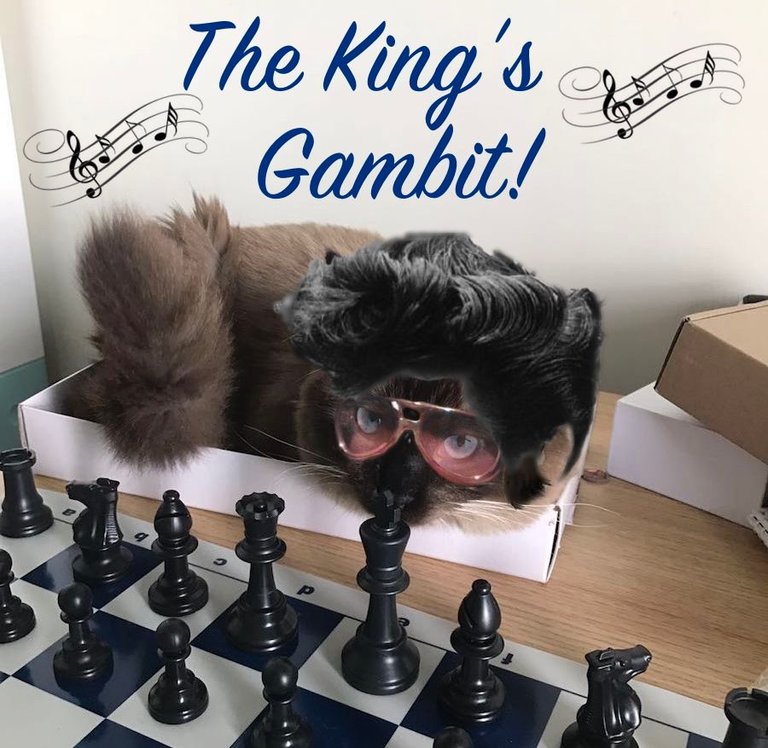
Hello! Time for another Chess Openings lesson. This is the 4th edition. These articles are fun looks over the history and strategy of specific chess openings, and also my personal method for memorizing some of the opening moves.
This is not a substitute for thorough chess study, but it's a good way to introduce yourself to some openings, get to know some history and hopefully get motivated to play the one and only, the most adrenaline pumping, ass-kicking, name-taking, head-banging of boardgames, the rock and roll king of the table!!! ...chess?
Parts 1-3 each looked at an opening, those being The Sicilian Dragon, The French Defense, and The Russian Game(Petrov Defense). Those can be found with these links:
Now, let's bring onto the stage today's opening, The King's Gambit! The King's Gambit barely makes the list of top ten openings, but it is one of the oldest, well known, and by some well-loved openings. It begins with:
1.e4 e5
2.f4

Right away white dangles the f pawn in front of black and asks him whether he wants it or not. Black usually takes the pawn, which gives white a couple of plans and slight advantage. If black doesn't take the pawn then things are even and if both sides play well tends to end in a draw. The latter is one reason the opening is not very popular at the highest level, the other being that many grandmasters feel like the so-called small advantage gained by white is actually a weakness that can be exploited. Namely that white is sacrificing king safety. We'll get into that. Us amateurs don't have to worry about that though. See, we get to have all the fun. At club level, this can be an aggressive opening for white that leads to fun, tactical play.
History

That's a page from the oldest chess book still in existence, from Luis Ramírez de Lucena (c. 1465 – c. 1530), a Spanish chess player. The King's Gambit is one of the openings described in the book, so yeah, it's pretty old. As old as I feel.
It's an opening that was popular for hundreds of years, it started to fade in popularity in the late 19th century, and some top players briefly played it regularly in the period following World War Two, since then it isn't seen that often at top level play. It was the opening played in perhaps the most famous chess game ever played, dubbed The Immortal Game, a game played in London in 1851; it's an amazing game, and white won. Just goes to show it can be a fun opening. In that game black accepted the gambit.
Top players that like the opening - Joseph Gallagher, Boris Spassky, Hikaru Nakamura, Nigel Short, Alexei Fedorov, and David Bronstein.
Top players that did not like the opening - François-André Danican Philidor, Siegbert Tarrasch, and Bobby Fischer.
It should be noted that even Bobby Fischer played it occasionally, although he disparaged it in his writings, even proclaiming his "Fischer Defense" as a refutation.

Strategy
So, white has put the f pawn out there for black to take, there are now two options, take it or not. The variations of the King's Gambit are split between King's Gambit Accepted(KGA) and King's Gambit Declined(KGD). KGA is the most popular so let's start with that.
1.e4 e5
2.f4 exf4
3.Nf3
Nf3 is the most popular 3rd move for white in the KGA. It prevents the black queen from moving to h4 and checking the king. Black's most popular response is g5. Let's look at the board at this point.

In this position, you can see that white is down a pawn, however, white has gained significant control over the center in exchange. White can continue with h4, Nc3, or Bc4. It's a very chaotic system with chances for both sides. In general a grandmaster who has studied can probably win as black, but unless you're playing someone rated over 2200 you'll have some great attacking chances for white.
h4 is the classic KGA move, Bc4 is a bold move that sacrifices even more king safety for white but leads to great attacks, and Nc3 is a move that is only recently played. Most top players just in the last year have mostly been playing 4.Nc3, which seems to work pretty well at getting white's minor pieces much more developed that black's. It's called the Quaade Gambit, I think because Dennis Quaade played it in the movie Innerspace when he was shrunken down in Martin Short's body.

Black has another response to 3.Nf3 besides g5, there is The Modern Defense That is also popular. Basically black says, sure I'll take that pawn, and then I'll focus on piece development and position, and not try really hard to keep my e pawn. It's a variation that may still leave white with a very slight advantage in the center, but basically it equalizes, essentially saying hey, let's just trade pawns. Boooooring. But, if your a slow, cautious player, that's a way to avoid the sharp play of many KG lines. See Below:

KGA Bishop's Gambit
Now let's look at 3.Bc4, also a common move in the KGA, known as the Bishop's Gambit. It lines the white bishop right up at black's weak f7 square, and the f file has been left semi-open because of the missing white pawn. That's strategy. This can be sharp as well, but generally still a more balanced game than if white plays 3.Nf3. After Bc4 black brings out the knight in preparation to get the king some room to move.

Other variations of white's 3rd move you could look at on your own for the King's Gambit Accepted are:
3.Nc3 – the Mason Gambit or Keres Gambit
3.d4 – the Villemson Gambit[27] or Steinitz Gambit
3.Be2 – the Lesser Bishop's Gambit or Tartakower Gambit
3.Qf3 – the Breyer Gambit or Hungarian Gambit
3.h4 – the Stamma Gambit
3.Nh3 - the Eisenberg Gambit
King's Gambit Declined
Now let's go into the King's Gambit Declined(KGD). As black, going into the KGD and deciding to not take the pawn offered by white, you're choosing to have a more even, calm game, not choosing the risky, sharp lines of the KGA where anything can happen. It is actually similar to the KGA modern defense. In fact, one opinion is that KGA modern defense(3...d5) is actually better for black's attempt at a more even, less sharp game than KGD. So if you want to kill white's fun and aggressive ideas, you might be better off taking the pawn, getting white's hopes up, then playing 3...d5 and making him all like wtf.
In KGD, there is the classical variation and The Falkbeer Countergambit. The classical variation is 2.Bc5, and the Falkbeer is 2.d5. They both are aiming for a more balanced center game rather than the sharp lines of KGA. The falkbeer seems to be a little more successful for black than the classical, so we'll stick with that one. Plus it has beer in the name.

The Falkbeer Gambit:

So you can see that if as black you play the Falkbeer, you have a nice fairly even fight for the center started.
King's Gambit Summary Ideas
Here are the main takeaways about the KG from this article.
As White, if you play the KG, you have to be ready for your opponent to join you for the wild ride or try to calm things down and force a balanced game.
As black, you play the wild game by taking the pawn, playing 2...exf4 and 3...g5. If you choose to do this, be prepared to play g4 if white plays h4, or Bg7 if white plays Bc4.
As black, if you want to balance things out, play the modern defense of KGA or don't take the pawn and play KGD. For the modern defense, take the pawn, then play d5. For the KGD, don't take the pawn, then play d5(falkbeer gambit).
As white, if you want to play the wild game, play h4 and get your Bishop to c4 and attack black's kingside, and bring your knight to c3 early attacking the center.
As white, if black plays the falkbeer or KGD, same thing, just bring the knight and bishop out but expect a more typical center battle to start.
Memorization
If you're not familiar with my memory system, follow the link above to my first lesson. It's not perfect, but it's better than nothing! Stay positive! Anyway, we'll make a mnemonic device for the KGA classical, The KGA modern, and the KGD Falkbeer Gambit.
KGA Classical
1.e4 e5
2.f4 exf4
3.Nf3 g5
Elvis and Ellie called Freddy. Ellie took Freddy on Friday night to play guitar.
KGA Modern defense
1.e4 e5
2.f4 exf4
3.Nf3 d5
Elvis and Ellie called Freddy. Ellie took Freddy on Friday night to go dancing.
KGD Falkbeer Gambit
1.e4 e5
2.f4 d5
3.exd5 exf4
4.Nf3 Nf6
5.Bc4
Elvis and Ellie called Freddy and Dana. Elvis danced and Ellie fainted. It was a fun, Friday night until the Bishop came.
Well, there you have it, now you have King's Gambit knowledge. There are endless possibilities and tons of other gambits and potential traps in the KG. It's unpredictability is one of the attractive things about it to its proponents, so this post only covers the basics. Here are my sources where you can find more detailed info, there are also plenty of Youtube videos on aspects of the KG:
- https://en.wikipedia.org/wiki/King%27s_Gambit
- http://www.thechesswebsite.com/kings-gambit/
- https://www.365chess.com/opening.php - Chess game database explorer
Hopefully you enjoyed that more than Sully did

Thanks!

I've never studied any chess moves. Good to know. #ssg
I like the second the last photo. Cute!
yep he's a cutie. grumpy though.
This post has received a 3.18 % upvote from @booster thanks to: @cryptastic.
This post received a 3.6% upvote from @randowhale thanks to @cryptastic! For more information, click here!
This post has received a 0.45 % upvote from @drotto thanks to: @banjo.
Congratulations! This post has been upvoted from the communal account, @minnowsupport, by cryptastic from the Minnow Support Project. It's a witness project run by aggroed, ausbitbank, teamsteem, theprophet0, and someguy123. The goal is to help Steemit grow by supporting Minnows and creating a social network. Please find us in the Peace, Abundance, and Liberty Network (PALnet) Discord Channel. It's a completely public and open space to all members of the Steemit community who voluntarily choose to be there.
If you like what we're doing please upvote this comment so we can continue to build the community account that's supporting all members.
That's a gem for a chess beginner like me, thanks! This makes me want to study again but I need to read up on a few key concepts before. And don't worry, the cat enjoyed it and probably thinks it'll beat you at chess!
haha I don't win all the time but I can proudly say I've never lost to the cat